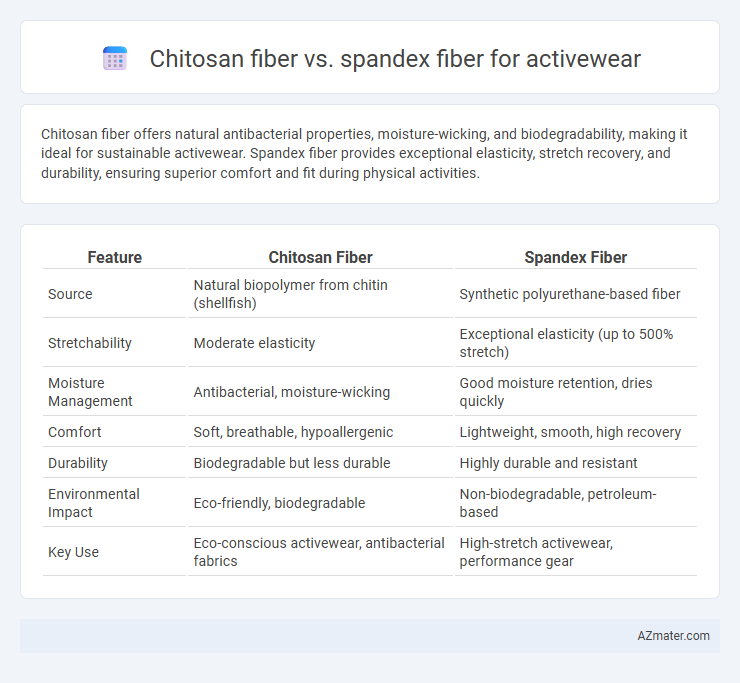Chitosan fiber offers natural antibacterial properties, moisture-wicking, and biodegradability, making it ideal for sustainable activewear. Spandex fiber provides exceptional elasticity, stretch recovery, and durability, ensuring superior comfort and fit during physical activities.
Table of Comparison
| Feature | Chitosan Fiber | Spandex Fiber |
|---|---|---|
| Source | Natural biopolymer from chitin (shellfish) | Synthetic polyurethane-based fiber |
| Stretchability | Moderate elasticity | Exceptional elasticity (up to 500% stretch) |
| Moisture Management | Antibacterial, moisture-wicking | Good moisture retention, dries quickly |
| Comfort | Soft, breathable, hypoallergenic | Lightweight, smooth, high recovery |
| Durability | Biodegradable but less durable | Highly durable and resistant |
| Environmental Impact | Eco-friendly, biodegradable | Non-biodegradable, petroleum-based |
| Key Use | Eco-conscious activewear, antibacterial fabrics | High-stretch activewear, performance gear |
Introduction to Chitosan and Spandex Fibers
Chitosan fiber, derived from chitin in crustacean shells, offers natural antibacterial properties, biodegradability, and moisture-wicking capabilities, making it ideal for activewear seeking eco-friendly performance. Spandex fiber, a synthetic elastane known for exceptional stretch and recovery, provides superior flexibility and shape retention critical in high-movement sportswear. Combining chitosan's bioactive benefits with spandex's elasticity enhances comfort, durability, and hygiene in modern activewear fabrics.
Key Properties of Chitosan Fiber
Chitosan fiber exhibits excellent bioactivity, antibacterial properties, and biodegradability, making it highly suitable for activewear that requires moisture management and odor control. It possesses natural moisture absorption and breathability, enhancing wearer comfort during intense physical activities. In contrast, spandex fiber is primarily valued for its exceptional elasticity and shape retention but lacks the antimicrobial and eco-friendly benefits inherent to chitosan fiber.
Key Properties of Spandex Fiber
Spandex fiber is renowned for its exceptional elasticity, allowing activewear to stretch up to 500% without losing shape, making it ideal for high-movement activities. Its lightweight, durable, and moisture-wicking properties enhance comfort by promoting breathability and quick drying during intense workouts. Spandex also offers excellent resistance to sweat, oils, and UV exposure, ensuring long-lasting performance and vibrant color retention in activewear garments.
Moisture Management and Breathability Comparison
Chitosan fiber exhibits superior moisture management capabilities due to its hydrophilic nature and antimicrobial properties, effectively absorbing and releasing sweat to keep skin dry during intense physical activities. Spandex fiber, while highly elastic and offering excellent stretch and recovery, lacks inherent moisture-wicking abilities, relying on blend fabrics to enhance breathability and moisture control. In activewear, chitosan fibers provide enhanced breathability and odor resistance, making them more suitable for prolonged wear in high-sweat conditions compared to spandex-dominant materials.
Stretchability and Comfort in Activewear
Chitosan fiber offers excellent moisture absorption and antimicrobial properties that enhance comfort in activewear, while providing moderate stretchability compared to spandex. Spandex fibers exhibit superior elasticity with up to 500% stretch, making them ideal for high-mobility activities requiring maximum flexibility. Combining chitosan's natural comfort benefits with spandex's exceptional stretchability creates advanced activewear designed for optimal performance and wearability.
Antibacterial and Odor-Resistant Benefits
Chitosan fiber exhibits superior antibacterial properties due to its natural polycationic structure, effectively inhibiting the growth of odor-causing bacteria in activewear. Unlike spandex, which primarily offers stretch and flexibility, chitosan's bioactive compounds provide enhanced odor resistance, making it ideal for prolonged workouts. Combining chitosan fibers with traditional synthetic materials can significantly improve hygiene and comfort in performance apparel.
Biodegradability and Environmental Impact
Chitosan fiber, derived from natural chitin found in crustacean shells, is biodegradable and offers a significantly lower environmental impact compared to synthetic Spandex fiber, which is petroleum-based and non-biodegradable. Chitosan fiber promotes eco-friendly activewear by breaking down naturally without releasing harmful microplastics, while Spandex contributes to long-term pollution and landfill accumulation. Choosing chitosan fiber supports sustainable fashion goals through reduced carbon footprint and enhanced material recyclability.
Durability and Maintenance of Fabrics
Chitosan fiber offers superior durability compared to Spandex fiber, as its natural antimicrobial properties reduce wear and tear over time. Maintenance of chitosan fiber activewear is easier due to its resistance to odor and bacterial growth, requiring less frequent washing than Spandex fabrics. Spandex fibers, while highly elastic and form-fitting, tend to lose shape and degrade faster with repeated washing and exposure to heat.
Cost-Effectiveness for Manufacturers
Chitosan fiber offers natural antimicrobial properties and biodegradability, appealing to eco-conscious activewear brands, but its higher raw material cost can impact large-scale production budgets. Spandex fiber remains the industry standard due to its superior elasticity and lower cost per yard, providing manufacturers with scalable, cost-effective stretch fabric options. Evaluating total lifecycle cost, including sourcing, processing, and consumer demand, determines which fiber aligns better with manufacturing margins in activewear.
Future Trends in Activewear Fiber Innovation
Chitosan fiber is gaining attention for its biodegradability, antimicrobial properties, and moisture-wicking capabilities, positioning it as a sustainable alternative to traditional activewear fibers like Spandex. Spandex remains favored for its exceptional elasticity and durability but faces challenges due to its non-biodegradable nature and environmental impact. Future trends in activewear fiber innovation emphasize the integration of bio-based materials like chitosan with performance-enhancing synthetics, aiming to balance sustainability with stretch, comfort, and functionality.

Infographic: Chitosan fiber vs Spandex fiber for Activewear
 azmater.com
azmater.com